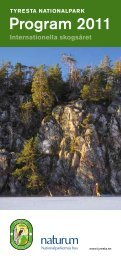Branden i tyresta 1999 Dokumentation av effekterna ISBN 91-620 ...
Branden i tyresta 1999 Dokumentation av effekterna ISBN 91-620 ...
Branden i tyresta 1999 Dokumentation av effekterna ISBN 91-620 ...
You also want an ePaper? Increase the reach of your titles
YUMPU automatically turns print PDFs into web optimized ePapers that Google loves.
they predominantly take f<strong>av</strong>our of the fungi<br />
that colonize the ground after a fire. Others,<br />
especially insects of prey, take f<strong>av</strong>our on the<br />
low concurrence from other species. Often,<br />
pyrophilous insects are able to locate fires<br />
at a long distance. Many of these animals<br />
h<strong>av</strong>e decreased during the 1900s due to a<br />
more effective fire-fighting and are today<br />
strongly threatened.<br />
The study in Tyresta was conducted with<br />
catching on chiefly six sites with different<br />
fire intensity rate, ranging from site 0 outside<br />
the burnt-off area and site 6 on intensively<br />
burnt ground. Different types of traps<br />
were mainly used, but at some occasions<br />
small very smoky fires were lighted at strategic<br />
places in order to attract pyrophilous<br />
insects. A special study of gnaw-marks from<br />
wood-living insects was also made.<br />
In general, the least intensively burnt<br />
parts of the area, typically the moister sections<br />
of the forest, were most important for<br />
the re-colonization of ground-living species,<br />
working as centres from which the lower<br />
animal life spread. The best catches were<br />
in mildly burnt spruce forest. Some species,<br />
on the other hand, were best represented in<br />
the intensively burnt areas, like Melanophila<br />
acuminata, a well-studied pyrophylous species.<br />
Nutritious pools was another interesting<br />
environment with a rich animal life.<br />
C. 30 truly pyrophilous species were<br />
recorded, chiefly beetles (19), mosquitos<br />
and flies (7) and micro-moths (2). Many<br />
small wildfires in the surroundings seem to<br />
h<strong>av</strong>e been f<strong>av</strong>ourable for many species. At<br />
the same time, many common wood-living<br />
insects were caught in unexpectedly low<br />
numbers.<br />
In the large material there are not less<br />
than 250 species that are new for Sweden<br />
and, furthermore, a number of previously<br />
undescribed species, among them a gall gnat<br />
which has been given the scientific name<br />
Tritozyga <strong>tyresta</strong>ensis.<br />
Influences on the chemical<br />
composition of water from<br />
wildfire and fire-fighting<br />
It is probably less recognised that a wildfire<br />
affects not only the animal and plant life but<br />
also the water quality in influenced streams<br />
and lakes. Water chemical effects following<br />
wildfires h<strong>av</strong>e been demonstrated mainly at<br />
investigations in North America, but there<br />
are few studies on this topic from Scandin<strong>av</strong>ia,<br />
why Tyresta is a very important<br />
research object after the wildfire of <strong>1999</strong>.<br />
A number of questions arose, e.g. if the<br />
use of brackish water from the Baltic Sea<br />
would influence the chemical composition<br />
of the influenced stream waters. Furthermore,<br />
the streams and lakes of the Tyresta<br />
forest are since decades included in several<br />
research- and environmental monitoring<br />
programs, which facilitates interpretations<br />
and comparisons.<br />
Four connected streams originating<br />
within the burnt-off area were studied, as<br />
well as the receiving Lake Stensjön. The samples<br />
were collected monthly during February<br />
to October <strong>1999</strong>—2004. Water chemical<br />
analyses were conducted and the frequency<br />
and composition of species among plant- and<br />
animal plankton were determined.<br />
The results clearly indicate a considerable<br />
influence on the water of the wildfire.<br />
Some effects occurred immediately after the<br />
fire and h<strong>av</strong>e since diminished; others h<strong>av</strong>e<br />
been more long-term and were sometimes<br />
still detectable in January 2004. pH dropped<br />
dramatically after the fire and the streams<br />
became very acid. This in turn affected pH<br />
dependant elements such as inorganic aluminium,<br />
which increased to toxic levels.<br />
Later, pH slowly increased again but never<br />
reached the pre-fire levels during the study<br />
period. A number of trace metals showed<br />
peak levels during the rainy period following<br />
the fire. The composition of major<br />
ions changed following the wildfire due to<br />
19




